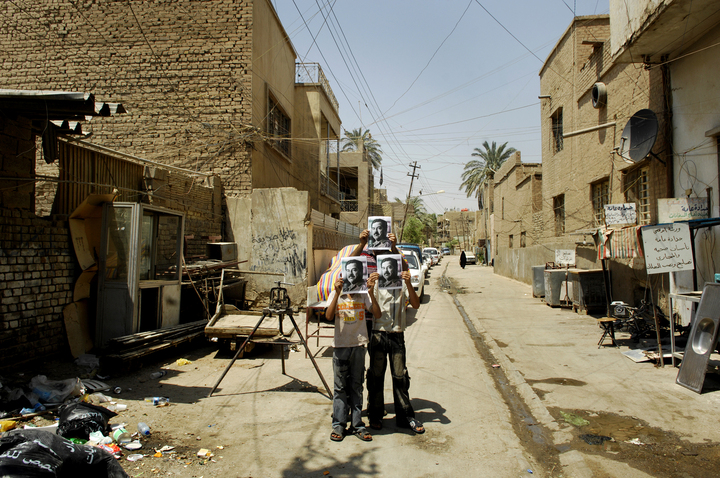
Jamal Penjweny, Saddam is Here, 2009-2010, photograph, size variable. Image courtesy of the artist and RUYA Foundation
The contemporary is quickly becoming outdated as culture now begins to approach and reassess visual media from the past decade. Two examples being, the recently released Errol Morris documentary about Donald Rumsfeld The Unknown Known and the photography of Jamal Penjweny exhibited at the South London gallery exhibition Welcome to Iraq which runs until 1 June 2014. Photography and film supposedly offer us the most realistic and clear view of historical fact, however what happens when we rely on a third party, the media, to transmit these images? Morris and Penjweny take retrospect and consideration to reassess the transmission. Morris and Penjweny reappropriate visual media associated with Iraq though their work opening up a dialogue on the possibility of misinterpretation between fact, the media lens and the viewer.
Morris presents his interview with former American Secretary of Defense, Donald Rumsfeld, who served under George W. Bush from 2001 to 2006 during the first years of the Iraq war. The documentary performs an upstaging of the politician centred around a snowstorm of memos, which Rumsfeld dictated compulsively during his years in office. Morris selects supporting evidence of press conference footage, headlines and photographs to form an offensive against jargon and deception which occurred at many levels. Blame is firstly placed with Rumsfeld who publicly miscommunicated the extent of Saddam Hussein’s personal involvement in the events of 9/11. The next culprit, however, is the media which performed this miscommunication through summarized, selected and simplified footage.
Addressing the photographic portrait of Saddam Hussein, photographer Penjweny constructs photographs which prompt a reassessment of the meaning of this image depending on our gaze. The photographic series Saddam is Here (2009–2010) shows Iraqis in everyday locations such as the street, hotels and shops, holding life sized black and white photographs of Saddam Hussein in front of their faces. Penjweny suggests how the dominance of the dictator replaced the identities of real people during his rule, “Iraqi society cannot forget him even after his death because some of us still love him and the rest are still afraid of him” (1). Saddam’s dictatorship existed from 1979, long before his life in the Western media spotlight. His portrait in Western media is summarized through the lens of the Iraq war and his political relations with America, yet for Iraqis this portrait holds another struggle associated with daily life.
The media has a direct responsibility for communication and looking at these two contemporary portraits, it’s interesting to see how easily video and image can be misleading. An image or video without context is not worth a thousand words. What other issues in the media today are being generalised by an icon or image? Why now, in the retrospect of a decade, are we looking back at this evidence, through culture (film and photography) to analyse objectively and understand the problems with it? This is where culture becomes the forensic process in our contemporary society.
Words: Harriet Thorpe
(1) http://www.jamalpenjweny.com/Foto.aspx?jmara=5





